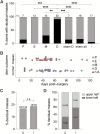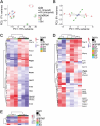Uterine injury during diestrus leads to placental and embryonic defects in future pregnancies in mice†
- PMID: 38206869
- PMCID: PMC11017118
- DOI: 10.1093/biolre/ioae001
Uterine injury during diestrus leads to placental and embryonic defects in future pregnancies in mice†
Abstract
Uterine injury from procedures such as Cesarean sections (C-sections) often have severe consequences on subsequent pregnancy outcomes, leading to disorders such as placenta previa, placenta accreta, and infertility. With rates of C-section at ~30% of deliveries in the USA and projected to continue to climb, a deeper understanding of the mechanisms by which these pregnancy disorders arise and opportunities for intervention are needed. Here we describe a rodent model of uterine injury on subsequent in utero outcomes. We observed three distinct phenotypes: increased rates of resorption and death, embryo spacing defects, and placenta accreta-like features of reduced decidua and expansion of invasive trophoblasts. We show that the appearance of embryo spacing defects depends entirely on the phase of estrous cycle at the time of injury. Using RNA-seq, we identified perturbations in the expression of components of the COX/prostaglandin pathway after recovery from injury, a pathway that has previously been demonstrated to play an important role in embryo spacing. Therefore, we demonstrate that uterine damage in this mouse model causes morphological and molecular changes that ultimately lead to placental and embryonic developmental defects.
Keywords: C-section; embryo spacing; injury; placenta accreta; placenta previa; pregnancy; uterus; wound healing.
© The Author(s) 2024. Published by Oxford University Press on behalf of Society for the Study of Reproduction. All rights reserved. For permissions, please e-mail: journals.permissions@oup.com.
Figures






Similar articles
-
Prenatal ultrasound diagnosis and outcome of placenta previa accreta after cesarean delivery: a systematic review and meta-analysis.Am J Obstet Gynecol. 2017 Jul;217(1):27-36. doi: 10.1016/j.ajog.2017.02.050. Epub 2017 Mar 6. Am J Obstet Gynecol. 2017. PMID: 28268196
-
Mouse Model of Surgical Uterine Injury and Subsequent Pregnancy Outcomes.J Vis Exp. 2025 Jun 27;(220). doi: 10.3791/67977. J Vis Exp. 2025. PMID: 40658646
-
MRI Signs Associated With Bladder Injury During Cesarean Delivery in Severe Placenta Accreta Spectrum Disorders.J Magn Reson Imaging. 2025 Jul;62(1):232-241. doi: 10.1002/jmri.29703. Epub 2025 Jan 9. J Magn Reson Imaging. 2025. PMID: 39781625
-
Soluble FMS-Like Tyrosine Kinase-1: Role in placenta accreta spectrum disorder.F1000Res. 2021 Jul 21;10:618. doi: 10.12688/f1000research.54719.4. eCollection 2021. F1000Res. 2021. PMID: 36127888 Free PMC article.
-
Lower Uterine Segment Corrugated Sutures in Hemorrhage during Cesarean Section because Previal and/or Placenta Accreta Spectrum: Case Reports Series and Literature Review.Z Geburtshilfe Neonatol. 2024 Aug;228(4):377-381. doi: 10.1055/a-2313-0948. Epub 2024 Jun 3. Z Geburtshilfe Neonatol. 2024. PMID: 38830385 Review.
Cited by
-
Mouse Surgical Model of Mechanical Uterine Injury and Subsequent Embryo Defects.Curr Protoc. 2024 Apr;4(4):e1044. doi: 10.1002/cpz1.1044. Curr Protoc. 2024. PMID: 38666634 Free PMC article.
References
-
- Wortman AC, Alexander JM. Placenta accreta, increta, and percreta. Obstet Gynecol Clin North Am 2013; 40:137–154. - PubMed
-
- Silver RM, Barbour KD. Placenta accreta spectrum: accreta, increta, and percreta. Obstet Gynecol Clin North Am 2015; 42:381–402. - PubMed
-
- Wu S, Kocherginsky M, Hibbard JU. Abnormal placentation: twenty-year analysis. Am J Obstet Gynecol 2005; 192:1458–1461. - PubMed
MeSH terms
Grants and funding
LinkOut - more resources
Full Text Sources
Molecular Biology Databases

